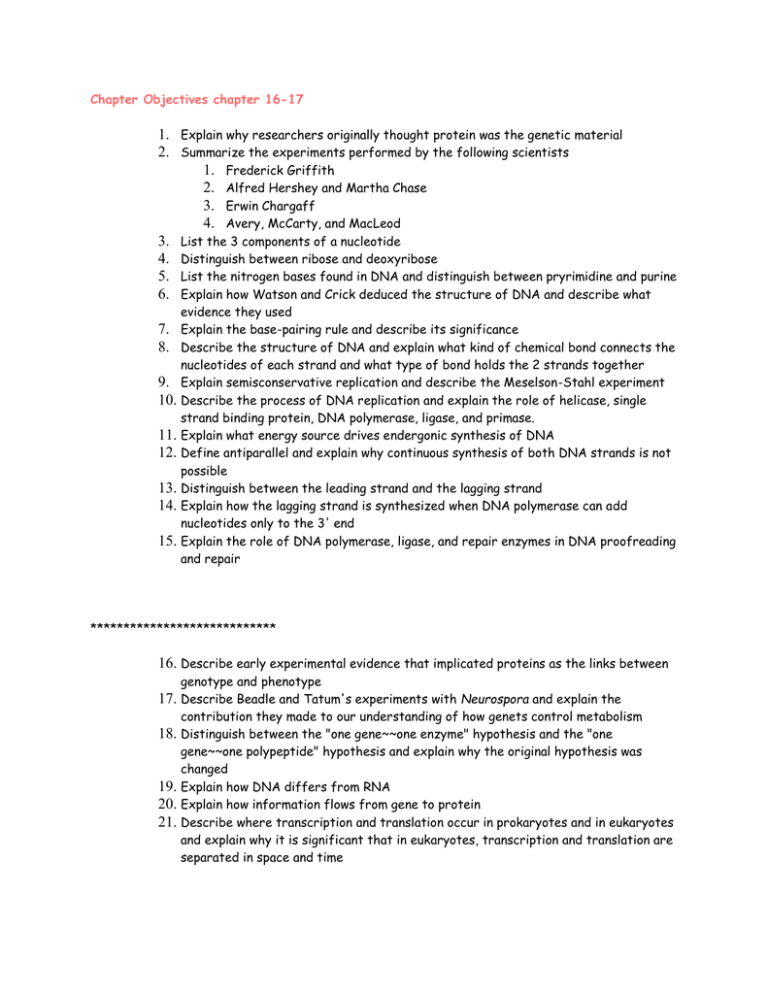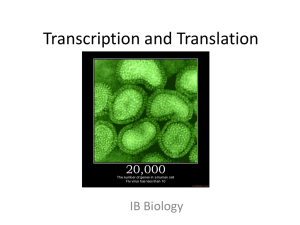Chapter Objectives chapter 16-17 Explain why researchers
advertisement

Chapter Objectives chapter 16-17 1. Explain why researchers originally thought protein was the genetic material 2. Summarize the experiments performed by the following scientists 1. Frederick Griffith 2. Alfred Hershey and Martha Chase 3. Erwin Chargaff 4. Avery, McCarty, and MacLeod 3. List the 3 components of a nucleotide 4. Distinguish between ribose and deoxyribose 5. List the nitrogen bases found in DNA and distinguish between pryrimidine and purine 6. Explain how Watson and Crick deduced the structure of DNA and describe what evidence they used 7. Explain the base-pairing rule and describe its significance 8. Describe the structure of DNA and explain what kind of chemical bond connects the 9. 10. 11. 12. 13. 14. 15. nucleotides of each strand and what type of bond holds the 2 strands together Explain semisconservative replication and describe the Meselson-Stahl experiment Describe the process of DNA replication and explain the role of helicase, single strand binding protein, DNA polymerase, ligase, and primase. Explain what energy source drives endergonic synthesis of DNA Define antiparallel and explain why continuous synthesis of both DNA strands is not possible Distinguish between the leading strand and the lagging strand Explain how the lagging strand is synthesized when DNA polymerase can add nucleotides only to the 3' end Explain the role of DNA polymerase, ligase, and repair enzymes in DNA proofreading and repair **************************** 16. Describe early experimental evidence that implicated proteins as the links between 17. 18. 19. 20. 21. genotype and phenotype Describe Beadle and Tatum's experiments with Neurospora and explain the contribution they made to our understanding of how genets control metabolism Distinguish between the "one gene~~one enzyme" hypothesis and the "one gene~~one polypeptide" hypothesis and explain why the original hypothesis was changed Explain how DNA differs from RNA Explain how information flows from gene to protein Describe where transcription and translation occur in prokaryotes and in eukaryotes and explain why it is significant that in eukaryotes, transcription and translation are separated in space and time 22. Define codon and explain what relationship exists between the linear sequence of 23. 24. 25. 26. 27. 28. 29. 30. 31. 32. 33. 34. 35. 36. 37. 38. 39. 40. 41. 42. 43. 44. codons on mRNA and the linear sequence of codons on mRNA and the linear sequence of amino acids in a polypeptide List the three stop codons and the one start codon Explain in what way the genetic code is redundant and unambiguous Explain the evolutionary significance of a nearly universal code Explain the process of transcription including the 3 major steps of initiation, elongation, and termination Explain the general role of RNA polymerase in transcription Explain how RNA polymerase recognizes where transcription should begin Specifically describe the primary functions of RNA polymerase II Distinguish among mRNA, tRNA, and rRNA Describe the structure of tRNA and explain how the structure is related to function Given a sequence of bases in DNA, predict the corresponding codons transcribed on mRNA and the corresponding anticodons of tRNA Describe the wobble effect Explain how an aminoacyl-tRNA synthetase matches a specific amino acid to its appropriate tRNA and describe the energy source that drives this endergonic process Describe the structure of a ribosome and explain how this structure relates to function Describe the process of translation including initiation, elongation, and termination and explain what enzymes, protein factors, and energy sources are need for each stage Explain what determines the primary structure of a protein and describe how a polypeptide must be modified before it becomes fully functional Describe what determines whether a ribosome will be free in the cytosol or attached to rough ER Explain how proteins can be targeted for specific sites within the cell Describe the difference between prokaryotic and eukaryotic mRNA Explain how eukaryotic mRNA is processed before it leaves the nucleus Describe some biological functions of introns and gene splicing Explain why base-pair insertions or deletions usually have a greater effect than base-pair substitutions Describe how mutagenesis can occur





